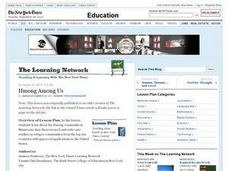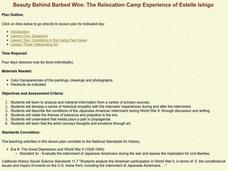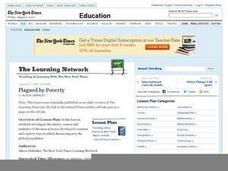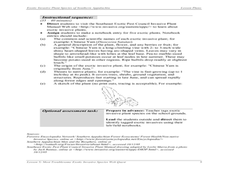Curated OER
Hmong Among Us
Students examine the Hmong community in Minnesota, then research and write case studies on refugee communities from the top ten countries with approved applications to the U.S. They write first-person stories from the perspective of...
Curated OER
Affidavit and Flyers from the Chinese Boycott Case
Students divide into small groups and study one of the three union flyers. Groups share their findings with the whole class and clarify unfamiliar vocabulary terms.
Curated OER
The Slave Trade
Students map and explore a possible slave trade route. In this slave trade mapping lesson plan, students calculate the distance and amount of time it would take for African slaves to arrive in America.
Curated OER
Seeing Your Jewish Community Through Different Eyes
Students analyze a variety of journal entries to view Jewish communities through different eyes. The first one is by Faimonda Koplnitsky. She emigrated from Ukraine as a girl and published a book, called "No Words to Say Goodbye."
Curated OER
Beauty Behind Barbed Wire: The Relocation Camp Experience of Estelle Ishigo
Eighth graders study World War II through art.
Curated OER
Social and Cultural Issues in the Civil Rights Movement
Students examine the society and culture during the times of the Civil Rights movement. They view video clips and answer comprehension questions. They work together to research different authors and musicians sharing their information...
Curated OER
Teen Refugees: Comparing Life Experiences
Students explore war refugees and their life experiences. After reading about refugees, students compare and contrast the experiences of teen war refugees with their own experiences. They write simulate writing letters as if they were a...
Curated OER
Breaking News English: France Continues to Deport Roma
In this English activity, students read "France Continues to Deport Roma," and then respond to 1 essay, 47 fill in the blank, 7 short answer, 20 matching, and 10 true or false questions about the selection.
Curated OER
Tracing Our Own Family Pilgrimages
Students observe a world map and are introduced to vocabulary like: cities, continents, rivers, lakes, and oceans. They discuss the names of the cities they live in and locate them on the map; then using a colored pushpin indicate: the...
Curated OER
Ideas and Commodities Cross Cultural Regions
Students compare and contrast how commodities native to certain countries have impacted the economies of other nations. After gathering information regarding how commodities are grown and traded, students use their information to...
Curated OER
Plagued by Poverty
Students investigate the nature, causes and statistics of diseases in lesser-developed countries and explore ways in which disease impacts the global population. They write a speech regarding disease in their country and how to prevent it.
Curated OER
The Study of the Spanish-Speaking People of Texas: Pictures, Images, and Photographs
Learners examine how art is used to make statements about social conditions. They analyze photos by the photojournalist Russell Lee, and complete a worksheet.
Curated OER
"Exploring U.S. Motives Behind WWII Imprisonment and Deportation of German, Japanese, and Italian Latin Americans"
Students research and examine the secret Special War Problems Division program in Latin America and discuss the impact of the program on civil and human rights. They assess the motives for the program and explore various quotes from that...
Curated OER
Most Troublesome Exotic Invasive Plant Species Web Quest
Learners participate in a Web Quest activity in which they identify common exotic invasive plant species of the Southern Appalachian Region. After identifying the top 10 exotic invasive species, they choose one to research in depth.
Curated OER
Come One, Come All
High schoolers analyze information from core map and other sources and construct routes from New York and Boston to Cincinnati as they might have existed in 1835.
Curated OER
Applications and Problem Solving
In this math worksheet, learners apply the skills of reading and critical thinking in order to create the solutions to the word problems.
Curated OER
Fertilizers, Pesticides and Human Health- American Lessons
High schoolers explore migration and why people move. They explore the movement of native populations. Students explore the economy as an factor in migration. They discuss the exploitation of the migrant worker.
Curated OER
Boston's Arnold Arboretum
Pupils examine how 19th-century urban conditions influenced the development of parks. They research local trees and shrubs, develop a display of trees and shrubs, plan a new park or arboretum, and write a report on a local park.
Curated OER
Measuring Citizenship
Twelfth graders explore citizenship. They discuss what makes a person a citizen of a country. Students examine the differences between resident aliens and naturalized citizens. They discuss the process for becoming a citizen and decide...
Curated OER
Further Reading: Japan
Students investigate the Japanese people and how they lived in the World War II era. They conduct research in order to obtain information. Then they role play the part of different people in groups who lived during the time.
Curated OER
Building the CPR
Tenth graders identify and clarify a problem, an issue, or an inquiry.They plan and conduct library and community research using primary and secondary print and non-print sources, including electronic sources. Students generate and...
Curated OER
The Eiserloh Story
Students read "The Eiserloh Story" and evaluate decisions made by the government in time of war. They determine if the government violated the rights of innocent civilians. They identify the Bill of Rights and analyze each Right.
Curated OER
Lambert Castle Museum, Great Falls, NJ
Young scholars complete a variety of activities that go along with the study of the 1913 silk strike in Great Falls, NJ. They examine evidence of historic industries and how they have changed in their own community.
Curated OER
Fort at No. 4 History
Students examine the history of Fort No. 4 in New Hampshire before visiting the site. They identify key events and people that occured at the fort as well. They complete questions and teach them to their group.

























